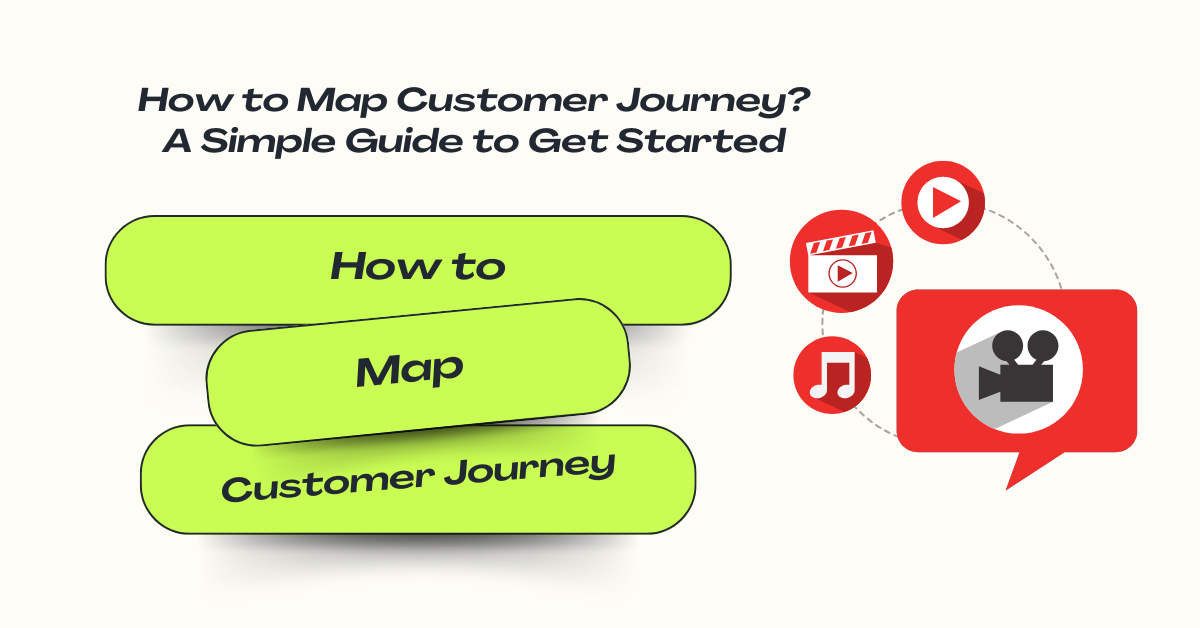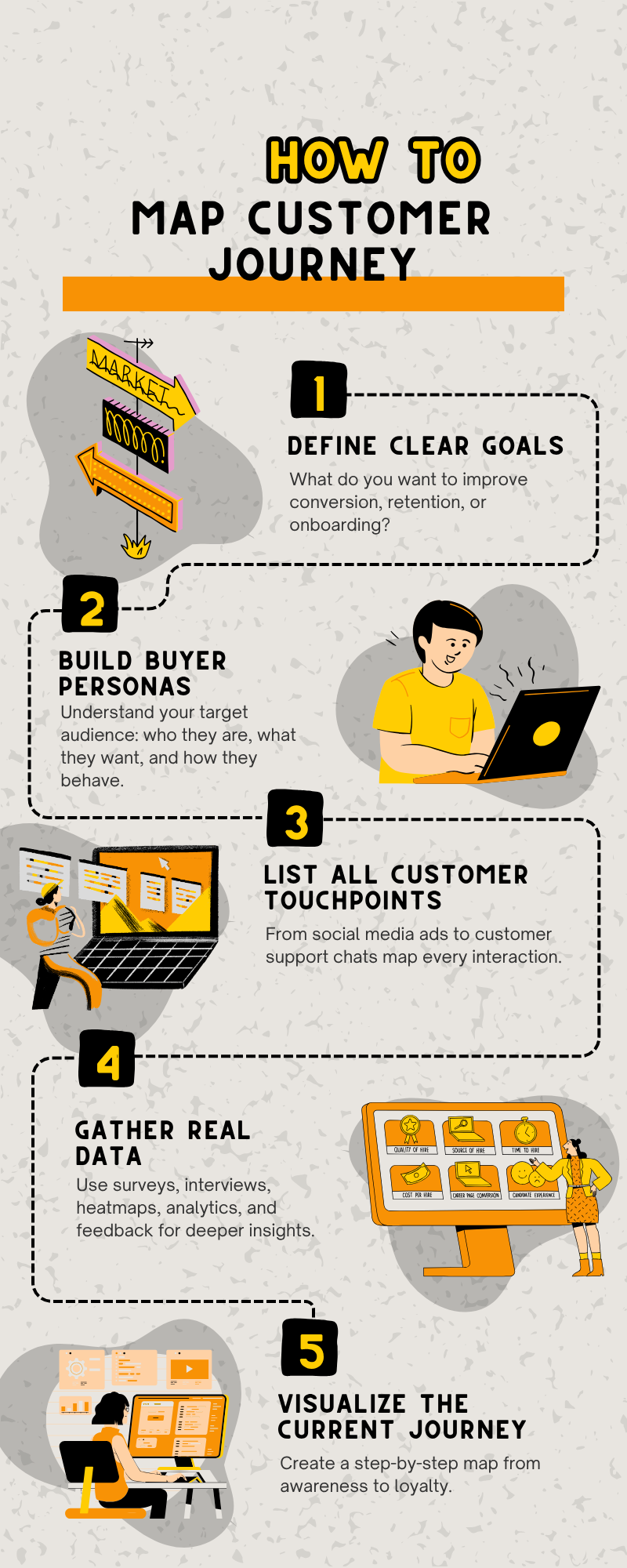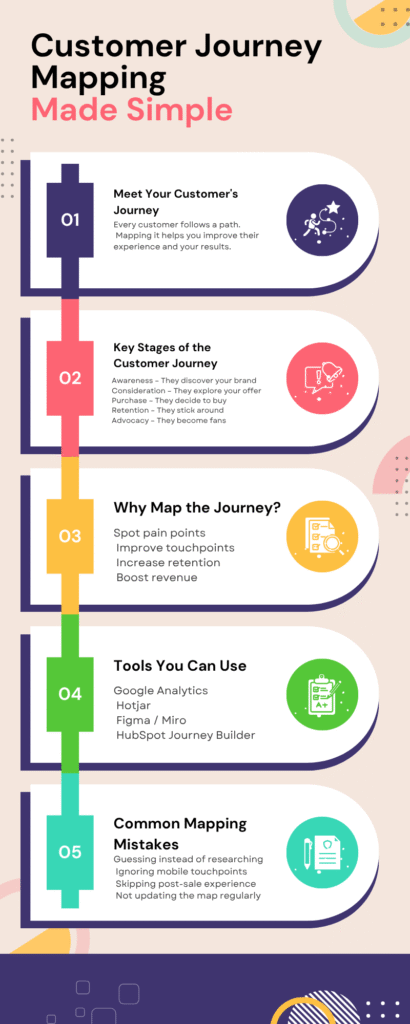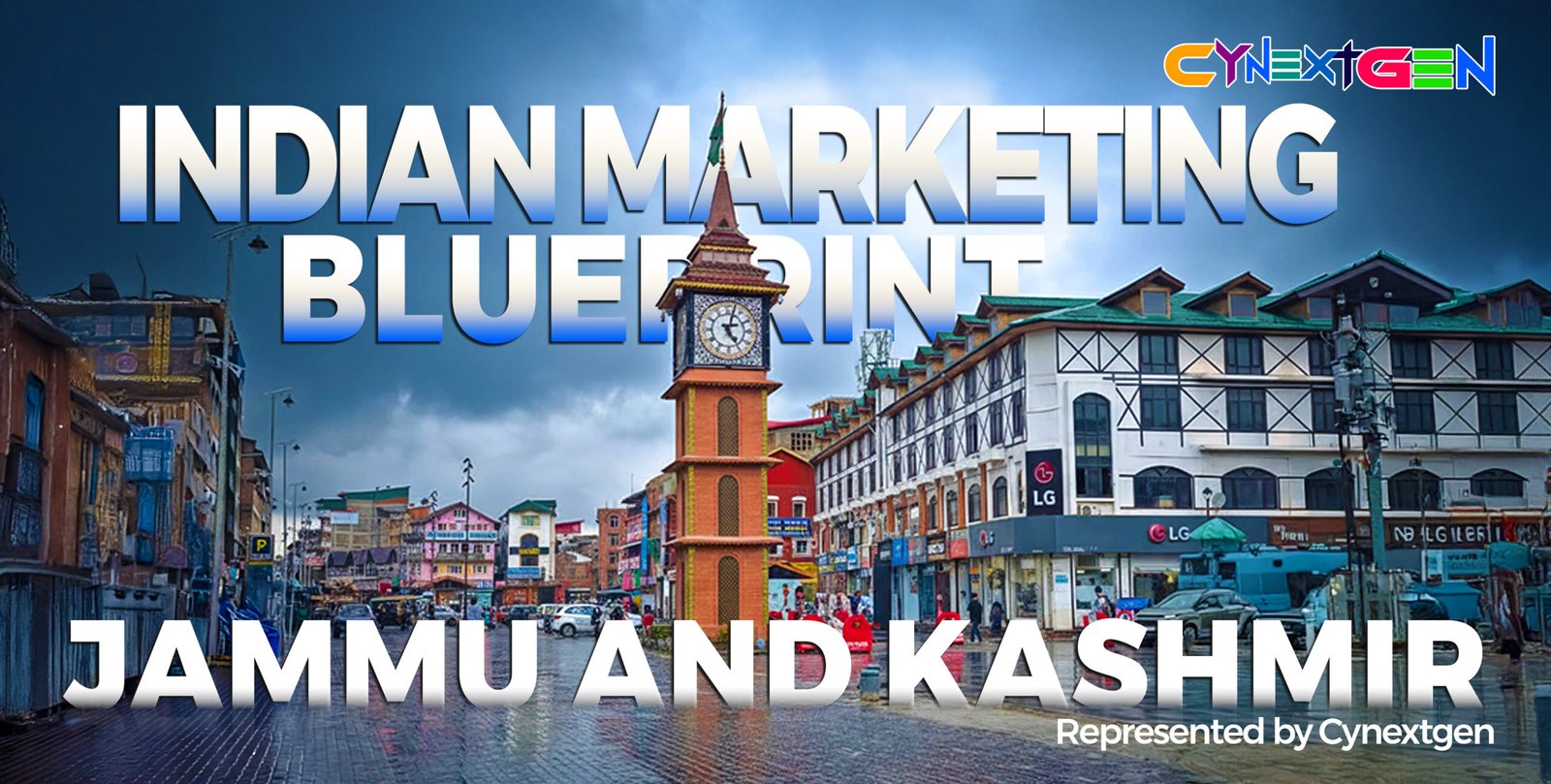
How to Map Customer Journey?
How to Map Customer Journey is essential for understanding the steps your customers take before, during, and after interacting with your brand. By identifying these stages, businesses can create better experiences, optimize touchpoints, and ultimately increase conversions.
Understanding the Customer Journey
Understanding How to Map Customer Journey? is critical for businesses aiming to provide a seamless and personalized experience. It allows brands to tailor their strategies to serve customers better, ensuring a higher level of engagement and satisfaction. Here’s how you can approach it:
1. Awareness: The First Step
The journey commences when customers encounter an item or company for the first time., the journey starts. This phase entails getting their attention via a variety of platforms, including advertisements, social media, and word-of-mouth. A strong hook is necessary to make an impression
2.Interest: Building Curiosity
Once aware, customers seek more information. This phase is crucial for deepening interest by providing valuable, informative content. Offering solutions to their pain points and showcasing product benefits can significantly increase curiosity and engagement.
3.Consideration: Weighing the Options
At this stage, customers compare different options before making a decision. Highlighting the unique features of your product, customer testimonials, or offering comparisons helps position your brand as a reliable choice over competitors.
4.Intent: Signs of Buying
When customers show intent to purchase, it’s time to optimize the experience. Offering special discounts or time-sensitive deals can push them closer to making a final decision. It is also when retargeting efforts are most effective.
5.Conversion: Making the Purchase
The conversion stage is where all efforts culminate in a sale.Businesses should ensure a smooth experience to prevent cart abandonment.
6.Post-Purchase: Nurturing the Relationship
After the sale, the customer journey doesn’t end. Building a lasting relationship is key. Follow-ups, loyalty programs, and personalized messages can keep customers engaged, encouraging them to return for repeat purchases.
7.Advocacy: Turning Customers into Advocates
Happy clients often turn into brand ambassadors, telling others that they had wonderful experiences. To assist with get the word out, promote user-generated content, reviews, and referrals. Word-of-mouth may boost brand trust and acquire new clients.
8.Mapping the Journey: Using Data to Improve
How to Map Customer Journey, allows businesses to identify pain points and optimize each stage. Using analytics tools to track customer behaviour helps refine strategies, ensuring continuous improvement and a better customer experience.
Importance of Map Customer Journey?
- Gives a clear view of customer behaviour: How to Map Customer Journey helps you see exactly how people interact with your brand at every stage. From the first click to the final purchase, it shows where they spend time and where they drop off.
- Identifies pain points: Every business has friction points that slow down conversions. A mapped journey highlights these moments, such as slow checkout pages or unclear product descriptions, so that you can fix them quickly.
- Improves customer experience: When you understand the path customers take, you can make it smoother. Small changes can increase satisfaction and boost loyalty.
- Helps personalise marketing: A mapped journey reveals what customers want at each stage. It allows you to send tailored messages, offers, or content that feel relevant and timely.
- Boosts conversion rates: By understanding when and why customers hesitate, you can provide them with the right nudge, such as a limited-time offer or a helpful tutorial, at the right moment.
- Aligns teams with one vision: Sales, marketing, and support often see customers differently. A visual How to Map Customer Journey creates a shared understanding, so all teams work toward the same goal.
- Uncovers opportunities for upselling: Journey mapping shows where customers are open to exploring more. You can position complementary products or upgrades without feeling pushy.
- Supports data-driven decisions: Instead of guessing, you use real insights to shape campaigns, improve products, and design better customer touchpoints.
- Strengthens customer retention: Happy customers return. By removing obstacles and enhancing the journey, you increase repeat purchases and long-term loyalty.
- Keeps you ahead of competitors: Many brands focus on short-term sales. Mapping the journey helps you create a long-term relationship that competitors can’t easily replicate.
Key Customer Journey Stages You Must Know
- Awareness – The stage where customers first discover your brand through ads, social media, or word of mouth.
- Consideration – They start comparing your product with competitors, reading reviews, and exploring features.
- Decision – The moment they’re ready to buy, influenced by trust, pricing, and perceived value.
- Purchase – The transaction happens, but the journey doesn’t end here.
- Retention – Keep customers engaged with great service, loyalty programs, or personalised offers.
- Advocacy – Happy customers recommend your brand, driving new leads through referrals.
How to Map Customer Journey in 7 Easy Steps?
First, define what you want to achieve. After that, craft buyer personas to understand more regarding the audience you are targeting. Identify all key touchpoints, from ads to emails to support chats. Gather real customer feedback to spot gaps. Visualize their journey using simple charts or tools. Pay attention to the areas where users hesitate or drop off. Finally, redesign the journey to make it smoother and more rewarding. This process helps improve customer experience, reduce friction, and increase conversions. Please keep it simple, practical, and based on real interactions.
1. Set Clear Goals for Your Journey Mapping
Before you map anything, know why you’re doing it.Pay attention to the areas where users hesitate or drop off Improve onboarding? Or understand where users feel frustrated? Each goal will shape how you build your customer journey map. For example, if your goal is to boost app retention, you’ll focus more on post-purchase interactions. Start with one core objective. Keep it specific, measurable, and tied to business impact. It makes your journey mapping more actionable and aligned with real customer experience improvements.
2. Define Your Buyer Personas
How to Map Customer Journey effectively, you need to define your buyer personas. It includes details like age, job role, goals, challenges, and buying behaviour. For example, a fitness app might target “Young Professionals” who want quick workouts between meetings. Knowing this helps you personalize the journey. When you truly understand who your customers are, every stage of the journey from awareness to loyalty becomes more relevant, engaging, and effective. It’s the first real step toward customer-centric marketing.
3. Identify All Customer Touchpoints
How to Map Customer Journey effectively, you must identify every point where a user interacts with your brand. These customer journey touchpoints can include seeing a social media ad, browsing your website, talking to support, or receiving a delivery. Think about the full experience from first discovery to repeat purchase. List both online and offline touchpoints. For example, a customer might see your product in a YouTube review before visiting your site. By mapping these moments, you can better understand what influences their decisions and where improvements are needed.Through the path, touchpoints draw focus on topics of conflict or enjoyment.
4. Collect Data from Real Customers
Mapping a realistic customer journey requires real consumer insights. Don’t assume what your users feel; ask them. Use surveys, support tickets, user interviews, or social media feedback to uncover their experience. Look for patterns in complaints, drop-offs, or praise. For example, if many users abandon carts after adding items, you’ve found a friction point. Real customer data shows what’s working and what’s broken. This step helps you move from guesswork to strategy, ensuring your journey map reflects the truth, not just your internal perspective. That’s how you build a map that actually improves experience.
5. Visualize the Current Journey (As-Is Map)
Before improving the customer journey, you need to see it as it exists today that How to Map Customer Journey. It is called the “As-Is” customer journey map. Start by tracing your customer’s real path from first interaction to final purchase and beyond. Use data like support tickets, user feedback, or website analytics. Highlight every touchpoint and emotion involved. For example, if users often drop off after adding items to the cart, that’s a red flag. This map helps you spot pain points and areas for improvement. Keep it visual, simple, and true to how users actually move through your brand experience.
6. Find Gaps and Customer Pain Points
You must identify gaps and places of friction in order How to Map Customer Journey. Keep an eye out for instances where users pause, complain, or drop off. These indicate areas where the experience is being negatively impacted. Use surveys, feedback forms, and support logs to identify them. For example, if users abandon the cart at checkout, the issue might be unclear pricing or slow page speed. Mapping customer pain points helps you fix real problems, not just guess. The goal is to remove confusion, reduce effort, and make every interaction smoother. A gap-free journey keeps customers moving confidently toward conversion.
Tools & Templates to Simplify Journey Mapping
Mapping a customer’s journey is a crucial part of any successful business strategy. But how can you do it effectively and efficiently? The answer lies in using the right tools and templates to streamline the process.
Journey How to Map Customer Journey helps businesses visualize customer experiences and identify pain points, opportunities, and areas of improvement. It can be overwhelming to start from scratch, but with the right tools and templates, it becomes a lot easier.
Key Tools for Customer Journey Mapping
Here’s a breakdown of some of the most useful tools for creating customer journey maps:
| Tool | Features | Best For |
| Smaply | Visualize customer touchpoints, create journey maps, personas, and more. | Teams looking for a comprehensive tool. |
| Miro | Whiteboard tool for collaborative journey mapping. | Collaborative teams and brainstorming. |
| Lucidchart | Offers diagramming tools to create flowcharts and journey maps. | Businesses with a focus on flowcharts. |
| Canvanizer | Simple, easy-to-use online canvas for creating journey maps. | Quick mapping for smaller teams. |
| UXPressia | Customised templates for effect maps, personas, and customer journey mapping. | UX designers and customer experience teams. |
| Microsoft Visio | A professional diagramming tool for mapping customer touchpoints. | Detailed, professional journey mapping. |
| Journey Mapper | Software developed specifically for mapping user encounters and customer journeys | Small to medium-sized businesses. |
| Zendesk | Helps map customer service touchpoints and enhance customer support. | Service-oriented businesses. |
These tools provide a range of functions, from visualizing touchpoints to collaborating with your team. Let’s have a deeper look at how to use them the best way possible.

Templates to Use for Journey Mapping
Templates simplify the entire mapping process, offering predefined structures that help organize customer interactions in an efficient way. Below are some essential templates to consider:
| Template Type | Purpose | Best For |
| Basic Journey Map | Tracks key touchpoints in a simple linear format. | Quick overview of the customer’s journey. |
| Experience Map | Focuses on customer emotions and pain points. | Identifying opportunities to improve CX. |
| Persona Journey Map | Combines customer personas with their journey path. | Personalized customer journey mapping. |
| Satisfaction Map | Highlights customer satisfaction levels at each touchpoint. | Understanding where customers feel most positive or negative. |
| Omni-channel Map | Integrates multiple customer touchpoints across various channels. | Businesses with multi-channel operations. |
| Service Blueprint | Includes detailed steps and processes to improve customer service. | Enhancing customer service experiences. |
| Empathy Map | Focuses on the thoughts, feelings, and actions of customers. | Deepening emotional understanding of customers. |
Why Use These Tools and Templates?
These tools and templates allow you to start quickly and effectively. For example, a Smaply or Miro template helps teams work together to map journeys across various customer touchpoints, while a UXPressia template offers a deep dive into persona-based mapping.
A well-designed customer journey map not only provides insight into how customers interact with your business but also reveals where improvements can be made. It can lead to better customer satisfaction, more successful marketing strategies, and ultimately, more conversions.
By using the right tools and templates, you’ll save time, collaborate more efficiently, and produce valuable insights that drive business success. These resources turn a complex process into a clear, actionable framework that any business can leverage.
Conclusion
In conclusion, embracing the best practices in SEO is crucial to boosting your website’s visibility and driving more traffic. Whether you’re optimizing your content, enhancing user experience, or leveraging strategic keywords, each aspect plays a vital role in achieving success. The key takeaway here is that SEO is not a one-time task, but an ongoing strategy that evolves with the digital landscape. Regular updates to content, fine-tuning keywords, and focusing on what users want can significantly improve your search engine rankings.






Add Comment